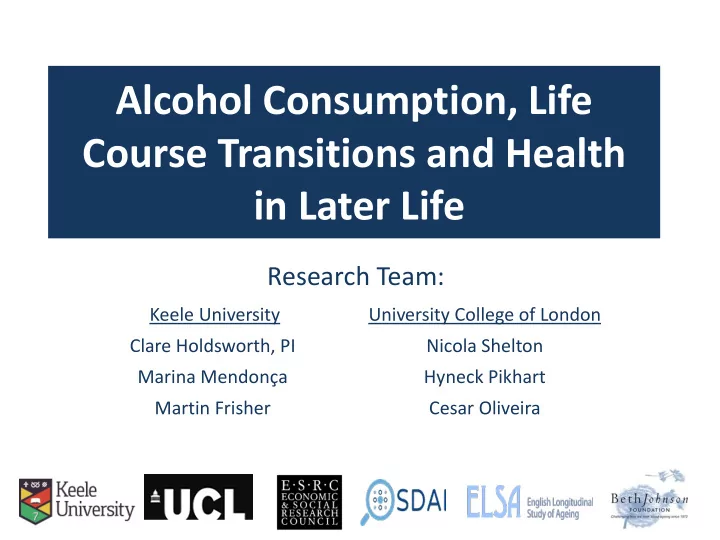

Alcohol Consumption, Life Course Transitions and Health in Later Life Research Team: Keele University University College of London Clare Holdsworth, PI Nicola Shelton Marina Mendonça Hyneck Pikhart Martin Frisher Cesar Oliveira
Objectives • To extend understanding of the diversity of patterns of alcohol consumption at older ages; • To identify the socio-demographic dynamics of drinking during later life and the life events that are associated with changes in drinking behaviours; • To explore the relationship between drinking and health conditions in later life; • To establish the importance of secondary survey data in supporting policy initiatives directed towards individual health behaviours; • To inform health policy initiatives on drinking in later life through identifying the risks associated with excessive drinking (binge drinking or drinking more than recommended weekly amounts) and the relationship between alcohol consumption, health and well-being in later life.
Data & Methodology • English Longitudinal Study of Ageing (ELSA): ELSA W0 (HSE): Baseline for alcohol variables 1998 1999 2001 W1 W2 W3 W4 W5 W6 2002/3 2004/5 2006/7 2008/9 2010/11 2012/13 • Practice-informed modeling approach in collaboration with Beth Johnson Foundation • Cross-sectional analyses : Association between alcohol consumption and socio-demographic and health variables • Longitudinal analyses : Sequencing drinking behaviours over life course; link between drinking behaviours and health; identifying whether changes in drinking behaviours are associated with individual characteristics
Exploratory Phase SOCIO-DEMOGRAPHIC AND DRINKING BEHAVIOURS: HEALTH VARIABLES: • Being a drinker ( drinking • Life course transitions status ) (e.g. employment status • Regularity of drinking • Socio-economic capital ( everyday drinking ) (e.g. income, education) • Amount of alcohol • Social Isolation (e.g. consumed weekly ( exceeding household size, marital status) • Health (e.g. self-reported recommended limits ) health Data : ELSA W0 (N=17150); Methodology : Cross-sectional
Descriptives (W0) Percentage distribution of alcohol variables by gender 100 90 80 70 60 50 men women 40 30 20 10 0 non-drinker drinker ≤ 4 drinking days almost/every day under or up to above drinking status everyday drinking recommended limits/week N = 17150; n (men) = 7685 (44.81%); n (women) = 9465 (55.19%)
Associations with drinking behaviours (only drinkers): coefficients of income 1.5 1.5 Predicting drinking almost/everyday: Predicting drinking almost/everyday: Women Men 1 1 0.5 0.5 0 0 -0.5 -0.5 -1 -1 -1.5 -1.5 Bottom 2nd 3rd 4th Bottom 2nd 3rd 4th Quintile Quintile 1.5 Predicting exceeding weekly rec. limits: 1.5 Predicting exceeding weekly rec. limits: Women Men 1 1 0.5 0.5 0 0 -0.5 -0.5 -1 -1 -1.5 -1.5 Bottom 2nd 3rd 4th Bottom 2nd 3rd 4th Quintile Quintile
Concluding remarks • Results are convergent with previous studies • Men are more likely to be drinkers, drink more often and drink in excess than women. • Income is one of the most important characteristics associated with drinking behaviours. Those in the highest income group drink more and more often. • Future: Important to disentangle the relationship between drinking behaviours, income and health in later life.
Recommend
More recommend